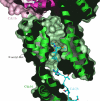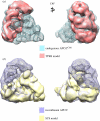Structural insights into anaphase-promoting complex function and mechanism
- PMID: 22084387
- PMCID: PMC3203452
- DOI: 10.1098/rstb.2011.0069
Structural insights into anaphase-promoting complex function and mechanism
Abstract
The anaphase-promoting complex or cyclosome (APC/C) controls sister chromatid segregation and the exit from mitosis by catalysing the ubiquitylation of cyclins and other cell cycle regulatory proteins. This unusually large E3 RING-cullin ubiquitin ligase is assembled from 13 different proteins. Selection of APC/C targets is controlled through recognition of short destruction motifs, predominantly the D box and KEN box. APC/C-mediated coordination of cell cycle progression is achieved through the temporal regulation of APC/C activity and substrate specificity, exerted through a combination of co-activator subunits, reversible phosphorylation and inhibitory proteins and complexes. Recent structural and biochemical studies of the APC/C are beginning to reveal an understanding of the roles of individual APC/C subunits and co-activators and how they mutually interact to mediate APC/C functions. This review focuses on the findings showing how information on the structural organization of the APC/C provides insights into the role of co-activators and core APC/C subunits in mediating substrate recognition. Mechanisms of regulating and modulating substrate recognition are discussed in the context of controlling the binding of the co-activator to the APC/C, and the accessibility and conformation of the co-activator when bound to the APC/C.
Figures












References
-
- Irniger S., Piatti S., Michaelis C., Nasmyth K. 1995. Genes involved in sister chromatid separation are needed for B-type cyclin proteolysis in budding yeast. Cell 81, 269–27810.1016/0092-8674(95)90337-2 (doi:10.1016/0092-8674(95)90337-2) - DOI - DOI - PubMed
-
- King R. W., Peters J. M., Tugendreich S., Rolfe M., Hieter P., Kirschner M. W. 1995. A 20S complex containing CDC27 and CDC16 catalyzes the mitosis-specific conjugation of ubiquitin to cyclin B. Cell 81, 279–28810.1016/0092-8674(95)90338-0 (doi:10.1016/0092-8674(95)90338-0) - DOI - DOI - PubMed
-
- Tugendreich S., Tomkiel J., Earnshaw W., Hieter P. 1995. CDC27Hs colocalizes with CDC16Hs to the centrosome and mitotic spindle and is essential for the metaphase to anaphase transition. Cell. 81, 261–26810.1016/0092-8674(95)90336-4 (doi:10.1016/0092-8674(95)90336-4) - DOI - DOI - PubMed
-
- Peters J. M. 2006. The anaphase promoting complex/cyclosome: a machine designed to destroy. Nat. Rev. Mol. Cell Biol. 7, 644–65610.1038/nrm1988 (doi:10.1038/nrm1988) - DOI - DOI - PubMed
Publication types
MeSH terms
Substances
Grants and funding
LinkOut - more resources
Full Text Sources
